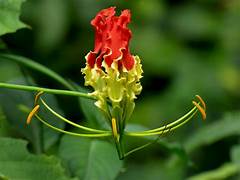DEPARTMENT OF BOTANY
MEDICINAL PLANTS
Gloriosa superba L.
Gloriosa superba, commonly known as the flame lily, glory lily, or tiger lily, is a striking and beautiful flowering plant from the family Liliaceae. It is renowned for its vivid, flame-like flowers and is native to the tropical and subtropical regions of Africa, Asia, and Madagascar. The plant is also noted for its medicinal properties and ornamental uses.
Botanical Details:
• Scientific Name: Gloriosa superba L.
• Family: Liliaceae
• Genus: Gloriosa
• Species: superba
• Authority: Linnaeus, 1753
Common Names:
• English: Flame Lily, Glory Lily, Tiger Lily, Gloriosa Lily
• Hindi: कमल छड़ी (Kamal Chhadi), बड़हिया (Badihiya)
• Malayalam: Menthonni, മേന്തോന്നി
• Tamil: செங்காந்தள்
Synonyms:
• Gloriosa rothschildiana Hook.f.
• Gloriosa superba var. lutea (yellow-flowered variety)
• Gloriosa superba var. vittata (striped variety)
Botanical Description:
o Gloriosa superba is a climbing plant that can grow up to 1.5–2 meters (5–6 feet) in height. It has tendrils at the end of its leaves, which help the plant climb and support itself on nearby structures.
o The plant has long, narrow leaves with a glossy green appearance. The leaves are lance-shaped and are arranged alternately along the stem.
o The stem is hairy and greenish, and the plant is generally vining or creeping, often seen growing on fences, trellises, or other supports.
Uses:
1. Ornamental Uses:
o Gloriosa superba is primarily grown for its aesthetic value. The plant’s dramatic flowers make it a popular choice for landscaping, especially as a climbing vine or in hanging baskets.
o It is commonly used in flower arrangements, bouquets, and decorative displays due to the unique and exotic nature of its flowers.
o It can also be planted along fences, trellises, or pergolas where it can climb and produce a beautiful floral display.
2. Medicinal Uses:
o Traditional Medicine: Gloriosa superba has been used in traditional medicine in various cultures, particularly in Africa and India, for a range of health conditions. However, caution should be exercised due to its toxicity.
o Pain Relief: The plant has been used to treat joint pain, rheumatic pain, and inflammation. A paste made from the plant is applied to affected areas to provide relief.
o Antifungal and Antibacterial: The plant’s tubers have been used in some traditional medicines for their antimicrobial properties, particularly against fungal infections and bacterial infections.
o Anticancer Properties: Some compounds in Gloriosa superba, particularly colchicine, have shown potential in cancer treatment. Colchicine has been traditionally used to treat gout, and it is being studied for its possible anticancer properties, particularly in the treatment of leukemia and other cancers.
o Toxicity: While it has medicinal value, Gloriosa superba is highly toxic if consumed in large quantities. The plant contains colchicine, a toxic compound that can cause nausea, vomiting, diarrhea, and kidney damage when ingested. It should only be used under the supervision of a qualified healthcare provider.
3. Culinary Uses:
o In some regions, the plant’s tubers have been used in traditional dishes, although it is not commonly consumed due to its toxicity.
o The use of Gloriosa superba in food is highly discouraged due to its poisonous properties.
4. Industrial Uses:
o The compound colchicine extracted from Gloriosa superba is used in pharmaceuticals, particularly for the treatment of gout and acute attacks of gouty arthritis. It has also been used in research for chromosome studies in plant breeding and cell division.

